
Recently on Cyclingnews.com |
Tech feature - November 3, 2005
Campagnolo looks to the future
All the attention in road bike components this year has been grabbed by SRAM, with the two established giants, Campagnolo and Shimano fielding tweaks and additions to existing ranges in Campagnolo's case and a predictable - albeit very welcome - mid-range ten-speed group in Shimano 105. But in the volatile business of bike components, to stand still is to court death, and Campagnolo has no plans to stand still. Campagnolo's Piero Da Rin told John Stevenson where the Big C is going for the next couple of years.
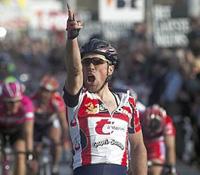
|
First, the bad news. Everyone who is waiting for Campagnolo to blow its competition out of the water with a production version of the Record electronic shifting system that has been in development for the last four years or so is going to have to be patient a while longer. According to Campagnolo's marketing manager Piero Da Rin, that component group needs at least two more years of development before it will be ready.
"At the moment it works perfectly," says Da Rin, "but it is untidy - cables all over the bike, batteries stuck on the frame. A road bike needs to be beautiful!"
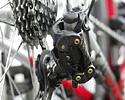
|
Of course, it's this dedication to aesthetics as well as function that has always endeared Campagnolo to its fans, so while technoweenies will no doubt be finding the long wait frustrating, at least we can be assured that when Record Electric becomes available it will look good.
A six year gestation for a new component set is not the standard at Campagnolo; the company is now developing parts for the 2008 product year, says dar Rin. But Record Electric has thrown up some unique technical challenges - that have sunk previous attempts at electronically-controlled shifting - and spun off some useful new technologies that have appeared in other areas of Campagnolo's range.

|
"We believe in product development," says Da Rin, "as it's a test field for our products," with improvements in the electrical shifting system leading to improvements in the existing mechanical system. "It's like Formula One," says Da Rin, giving as an example the improvements in front derailleur shifting Campagnolo has made in recent years.
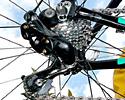
|
Campagnolo found very early in the development of Record Electric that shoving a chain from one chainring to another needed a lot of force. That in turn required a powerful motor to make the shift and a big battery to supply the juice, all of which meant extra weight. This problem in turn led to an effort to improve chainring tooth shapes, chain shapes and front derailleur plates so that less force would be required to move the chain.
This year, riders using Record Electric have finished on top of the podium, most notably Nico Eeckhout in Dwars door Vlaanderen back in March. "Everything worked 95 percent" in the early season races, says Da Rin, and Campagnolo was able to further improve the system as a result of feedback from its riders.
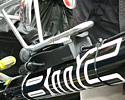
|
The Spring races in northern Europe are a, "great test field because of the weather and the big, strong riders," who dominate those races, says Da Rin. However, in the hardest test of the year, Paris-Roubaix, Record Electric equipped bikes only went half the distance before being swapped out for machines with mechanical transmissions.
Nevertheless, Da Rin says it's aesthetic considerations that are now holding things back. "We are working on several ways to make Record Electric look good, but it's too early to say what they are because they might not make production." Cyclingnews suggests some obvious ideas, like hiding it in the frame, and you can tell this sort of thing has occurred to Campagnolo and been discarded. Frame manufacturers historically aren't keen on being told to build frames around someone else's parts.
The near future

|
Record Electric, then, will be ready when it's ready. Rumours are already circulating that Shimano's XTR mountain bike group will have lots of carbon and titanium for 2007 and that will inevitably lead to a revamped, lighter Dura-Ace in 2008. Da Rin says Campagnolo will be ready for the challenge.
"Compared to Shimano we use more titanium and carbon in our top line group which lightens it. The Record rear derailleur, for example, is almost all carbon." In fact, he feels it's not fair to compare Record to Dura-Ace; Chorus a better benchmark. "The Chorus group is just 40g heavier than Dura-Ace."

|
"We are ready to face competition," says Da Rin. "We know SRAM is coming and maybe FSA. Increasing competition is part of the world."
Next year will see the first salvo in Campagnolo's response to new competition with "something very new. We are looking at [redeveloping] our oldest part," says Da Rin, before clamming up and refusing to drop Cyclingnews any more hints, despite our pleading. Some guesses? Campagnolo's original big idea was the wheel quick release, but it's hard to imagine getting very excited about a new QR design (and anyway, Campagnolo's 2006 wheels feature the very tidy quick release found on Fulcrum wheels).
How about a new bottom bracket design? The square taper is arguably the oldest design in Campagnolo's stable and other manufacturers have taken advantage of the weight savings offered by two-piece cranks with external bearings. This is definitely an area where it would seem Campagnolo could use some innovation. And that's enough speculation from us!
The wheel thing
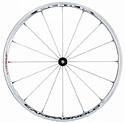
|
One area where Campagnolo has innovated and taken on its competitors in the last couple of years is wheels. That area has, "gone crazy," says Da Rin, adding that it's, "the most difficult part to innovate."
When Cyclingnews points out that riders looking for reliability always seem to pull out old-fashioned wheels with 32 spokes for Paris-Roubaix, Da Rin is quick to respond, pointing out, "Magnus Backstedt won Paris-Roubaix on Neutron wheels and was fourth in 2005."
At this point Felice Santaro, Campagnolo's Australian technical representative and Da Rin's host for his visit to Australia, points out that he is seeing dealers recommending Campagnolo wheels to riders of Shimano-equipped bikes, citing their reliability. (To be fair to Shimano, we know dealers who swear by the durability of Dura-Ace wheels.)
Campagnolo split its wheel effort in two a couple of years ago, introducing Fulcrum wheels. Fulcrum is a wholly owned subsidiary of Campagnolo, but run as a separate company, says Da Rin. "There is separate R&D but some common manufacturing," he explains.
That has allowed Fulcrum to experiment with substantial departures from traditional wheel technology - Neutrons may be reliable enough for Paris-Roubaix, but with their steel spokes they are in some ways quite traditional. For 2006 Fulcrum features such as lightened rims and flattened aluminium spokes have crossed over to Campagnolo.
Back in the dirt?
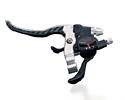
|
One area of bikes where Campagnolo has been absent for many years is the off-road arena, but the company's recent triple chainset, trigger shifters and V-brakes - intended for flat-bar road bikes - mean it's almost possible to build a Campagnolo-equipped mountain bike again. But Campagnolo has no immediate plans to return to the mountain bike arena.
Campagnolo might make MTB parts, "potentially, in the future, but we don't have a clear plan," says Da Rin. Campagnolo's last attempt at mountain bike components, back in the early to mid-90s, came at a bad time for the company. "It was both too late and too early," he says. Campagnolo in the early 1990s was floundering, and needed to focus on what it did best, road components. It just didn't have the resources to take on Shimano in its strongest area.
But Campagnolo now is a much healthier company with a raft of the kind of materials technologies that appeal to mountain bikers. So will off-road riders get a third option in components too? "We'll see," says Da Rin.
Related articles
Campagnolo's electronic
group V2.0
Eeckhout wins on Campagnolo Electric
More Campagnolo Electronic
Bikes of Paris-Roubaix
2005
Campagnolo's test pilot

